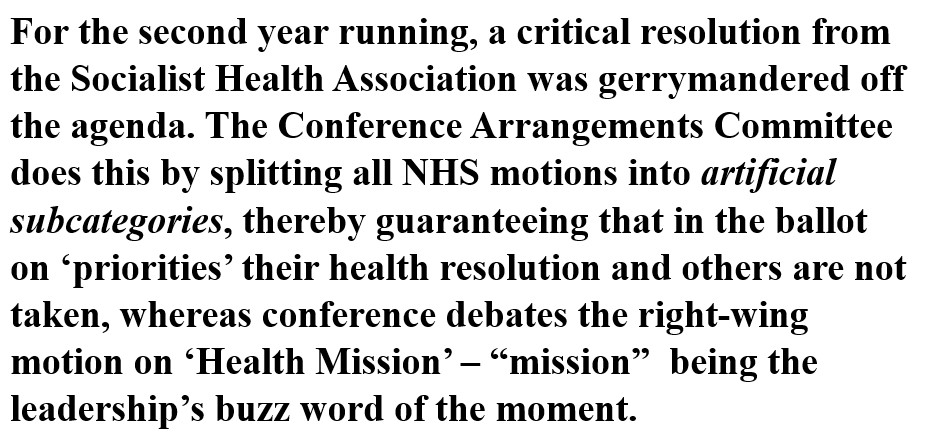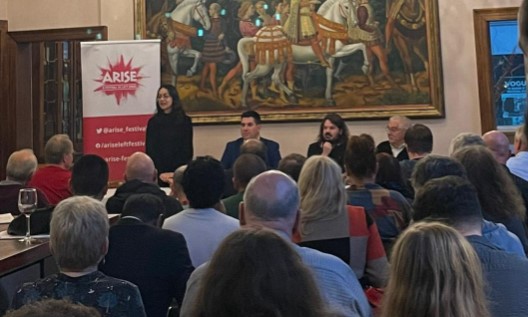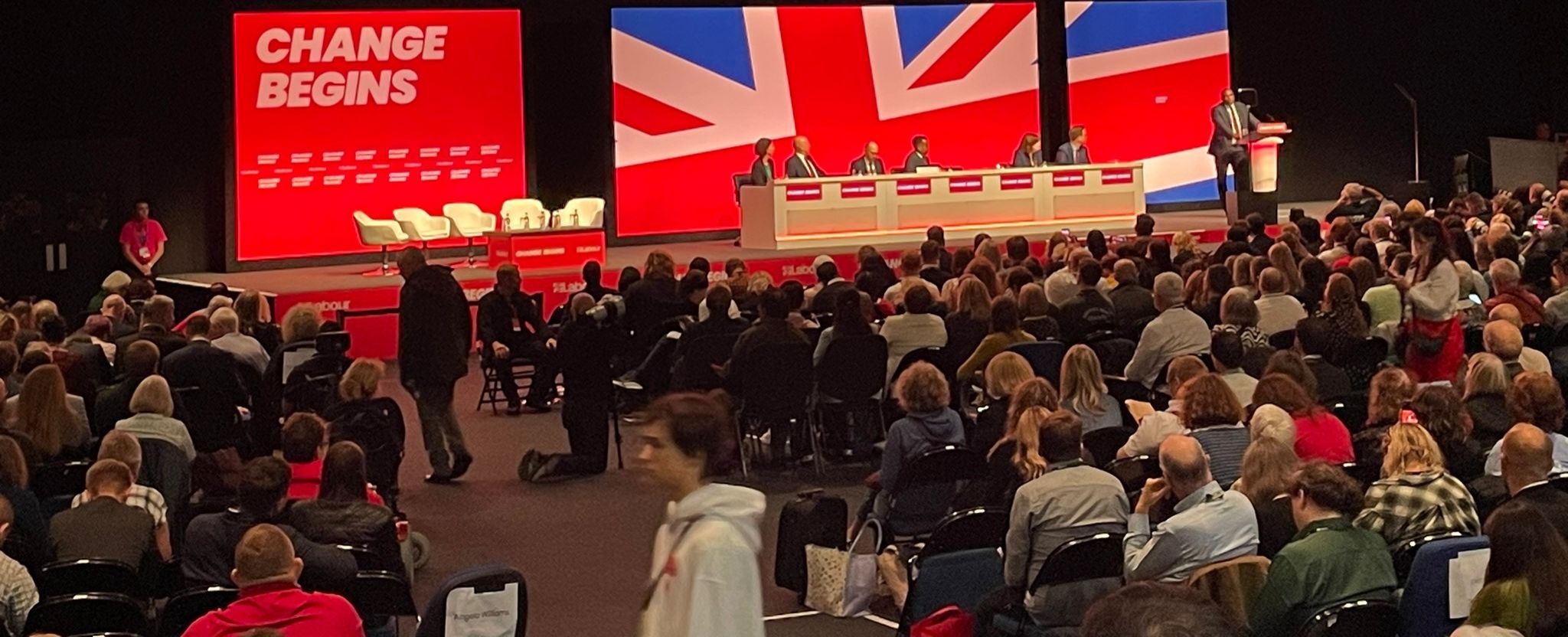Labour Party conferences are not necessarily important in themselves, because although they shouldn’t, Labour leaders generally ignore the democratically-arrived decisions of the Party membership. But a conference can be important in giving an indication of the mood of party and trade union members and the balance of forces between left and right.
This year’s conference was meant to be a celebratory event, with the leadership receiving the accolades and hearty cheers from the assembled delegates, to a man and a woman grateful for the end of the Tory government. To that end, the NEC and conference organisers choreographed the whole event to show the leadership in the best possible light.
But to quote the reporter from the Financial Times, who clearly did not understand what was going on, it was a “weird” event. A better description, also used by the FT, is that it was a bit “tetchy”. The right wing faction completely controls the Labour apparatus and conference arrangements so they were able to gerrymander the agenda so that critical motions were either removed altogether, like the SHA resolution, or shuffled to the end, like the that from Unite and the CWU. But they cannot wish away the growing growls of dissent from below.
Right wing lack confidence in taking on the arguments
What we have to see is that if the leadership and the conference organisers feel the need to manoeuvre away critical resolutions, it is an indication of weakness rather than the opposite. A confident leadership would have been able to meet any dissenting arguments head-on and beat them, but that is something Labour’s right wing simply cannot do.
The right may dominate conference – only around one in six of the CLP delegates can be described as ‘left’, and perhaps a third from the trade unions – but they face the harsh realities of an unpopular leader, a public display of political sleaze over ‘gifts’ and the very unpopular cuts in winter fuel allowance. To come so early in the life of a Labour government, such problems are unprecedented.
Trade union delegates and even working class right-wing members of the Party are already under pressure over the certainty that Rachel Reeves and Keir Starmer are cooking up a new round of austerity. In their set speeches, both of them explicity denied the word “austerity”, but the direction of their policies point at no other conclusion, and everyone knows it. “Difficult choices”, “unpopular decisions”, “short-term pain for long-term good”, etc, are just the verbal dressing around policies that will reduce public spending in many key areas – a notable exception being Defence.

Keir Starmer’s remarks about cracking down on benefits could have been made by any Tory minister any time in the past fourteen years. His comments are a straw in the wind, a hint of what is to come.
The PLP – mostly a gaggle of careerists and chancers
Starmer’s strategy is backed by the Parliamentary Labour Party, mostly a gaggle of careerists and chancers further removed from the working class than at any time in the Party’s history. It is also backed by Party apparatchiks, whose main task seems to be stifling open discussion, debate and democratic candidate selection within the party, for fear of letting in any dissent.
But what was clear from this conference is that the right wing do not have it all their own way and, if anything, their grip is going to get looser. There were, of course, those delegates who were always ready to give standing ovations and applause for anything a minister said. But alongside this claque there were hundreds of others who were, at best, subdued and at worst showed outright hostility to the direction of the government – and this is a government in office for only three months.
Despite all the shrill demands for a ‘new’ party for workers, the Labour fringe – with big meetings on Palestine and many other issues – as well as the main conference proceedings, show that the left of the party is far from dead. The right wing manoeuvre desperately precisely because they are afraid that the left will come back. That is particularly true for those parts of the Labour organisation where the right cannot guarantee control – the affiliated unions.
Despite the manoeuvring of conference organisers, they could not in the end avoid the humiliation of a highly critical composite motion from Unite and the CWU, even thought it was pushed to the final day. It is worth looking at some of the detail of that composite.
The first sentence went straight to the point: “…workers and communities voted for change – a better future, not just better management and not cuts to the winter fuel allowance”. The motion outlined the cuts in public services and the NHS, but noted “Alongside this, profiteering has flourished, short-term profits are favoured over long-term investment and working people have paid the price through real-terms wage cuts.”
The key demands at the end of the resolution were to:
1. Reverse the introduction of means-testing for the Winter Fuel Allowance
2. Ending the fiscal rules which prevent borrowing to invest
3. Commit to public services and infrastructure, ensuring any public expenditure gaps, at a minimum, are restored through taxing wealth and that there are no further cuts to welfare provision for working people and pensioners.
4. Introducing a wealth tax on the top 1%, an excess profits tax, equalise capital gains tax with income tax and apply national insurance to investment income
5. Delivering the investment necessary for a workers’ transition to Net Zero
“We are the sixth richest economy in the world; we have the money.” Sharon Graham said, in moving the motion, “Britain needs investment, not austerity mark II. We won’t get any gold badge for shaving peanuts off our debt”.

Starmer has already said that conference decisions are “not binding” but for us, the passing of this resolution on a show of hands is an important indicator of the mood of ordinary Labour and trade union members. Even more importantly, it is an indication of the direction in which the grass roots of the party will go in the coming months. Up in the political stratosphere, Labour ministers will blithely toe the line and carry out policies that can best be described as ‘Tory-lite’.
But on the ground, in working class communities and workplaces, Labour councillors, Labour members and trade union officials, will be harangued from pillar to post over policies that will be seen to damage the lives of working people. It is not a matter of ‘if’ but ‘when’ that a sizeable opposition will develop inside the Labour Party, to the trajectory of the government and the key to that will be the temper of the affiliated trade unions.
CLPs hamstrung by regional bureaucrats
Constituency Labour Parties are hamstrung by regional Labour bureaucrats; honest, working-class Labour councillors are tied up by right-wing Labour council leaders, and some, inevitably, will resign in disgust. But within the trade union movement, where the membership are able to assert pressure directly on their election national committees and officers, there will be no stopping a groundswell of dissent.
The challenge for left trade union leaders is that they need to realise what is at stake and what it is necessary to do. It was refreshing that Sharon Graham was able to make an impact in conference, especially given that she boycotted her first Party conference after being elected. But she and other left trade union leaders need to understand that Labour’s right wing are utterly immune to any appeals, arguments or resolutions.
The Trade unions must become the centres of resistance to Starmer’s new austerity, both outside the party, in workplaces, but also in the internal life of the party. The left leaders of the trade union movement and left Labour MPs need to actively organise against the right faction that control the party, to roll back their power and influence.
Through regional conferences and national conferences, through elections to Regional Committees and the National Executive Committee, through the work of TULO, through the selection of councillors and parliamentary candidates, the trade union lefts needs to collaborate with each other and pursue a strategy that aims at a change of leadership, but, above all, a change of policy and direction at the top.
Socialist policies are not just a historical quirk, or the subject of fine speeches at traditional labour movement rallies. They exemplify the essential needs of the hour, if working class livelihoods, jobs and services are to be improved or even preserved in the coming years.



